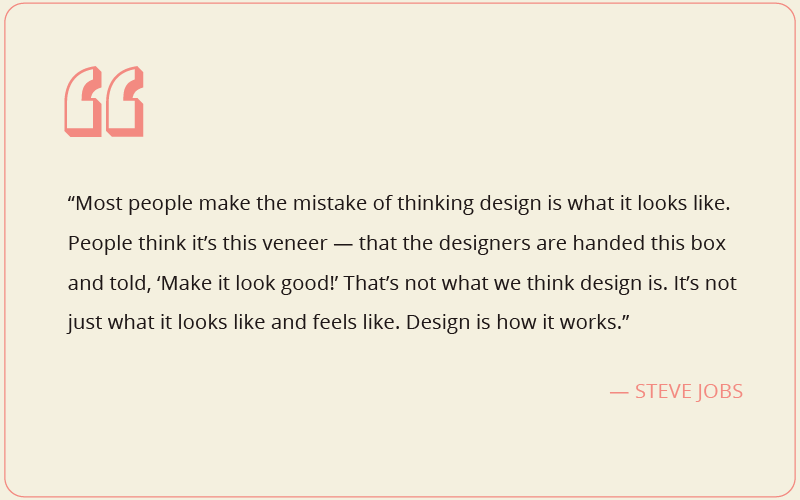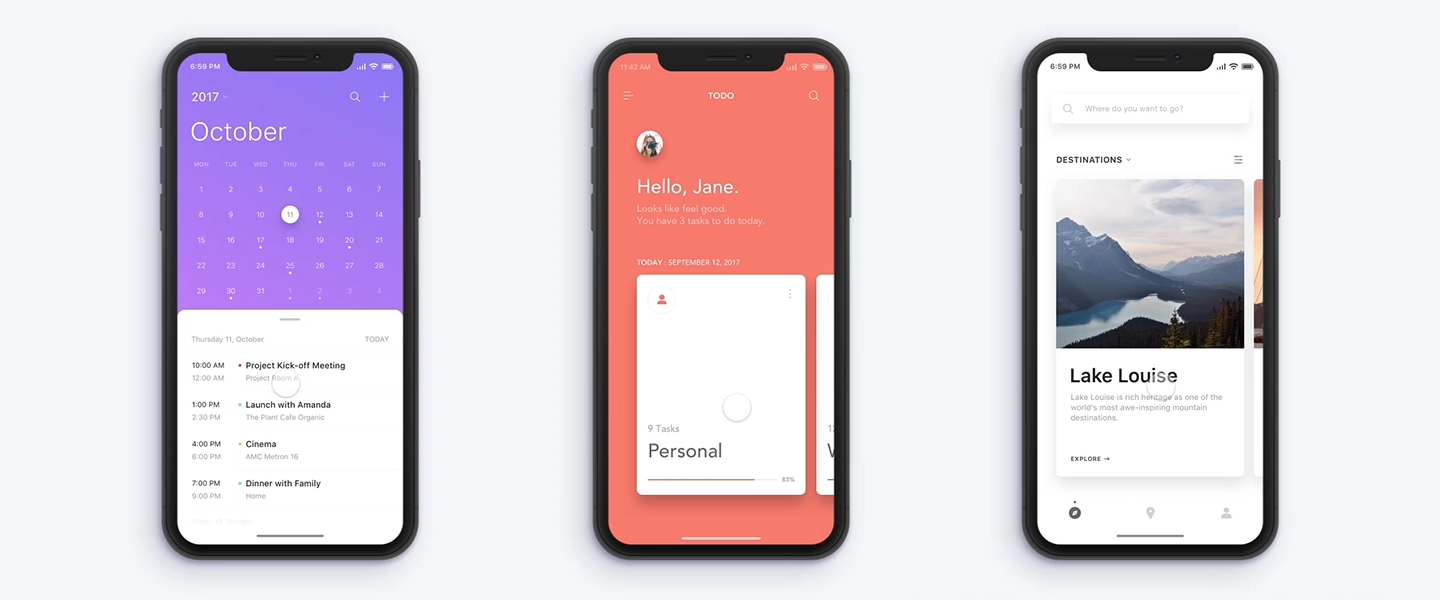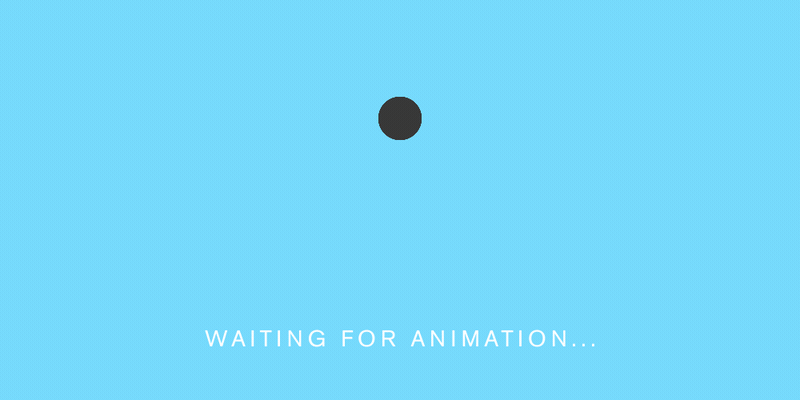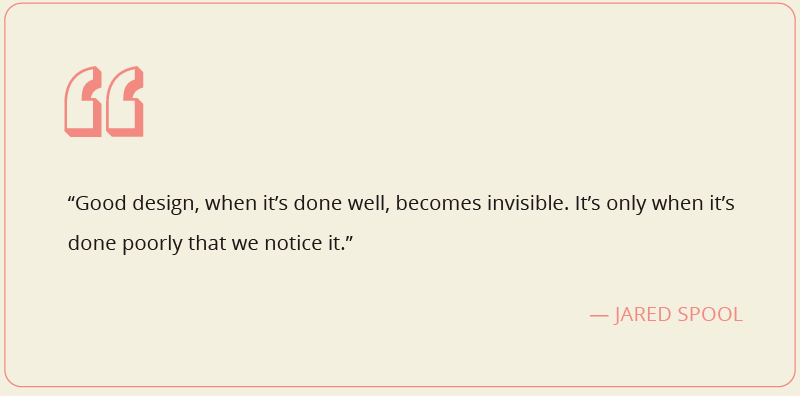This article was updated on 10/04/2025
One of the most memorable Steve Jobs quotes that exemplifies the idea of invisible design.

Good design doesn’t scream for attention — it just works, making things feel smooth, simple, and spot-on without you even noticing.
- Good design is invisible — when done right, users don’t notice it because everything feels natural, intuitive, and easy to use.
- Poor design stands out — cluttered interfaces and confusing layouts frustrate users and hurt engagement, credibility, and business performance.
- Design isn’t just decoration — it’s a strategic asset that impacts user experience, brand trust, and even revenue growth.
- Simplicity is powerful — from Google’s homepage to highway signage, the best designs are minimal, intentional, and user-centered.
- Investing in design pays off — companies that prioritize thoughtful design consistently outperform their competition and build stronger customer relationships.
So why is it that good design is invisible? There’s an ever-present lack of awareness on design’s impact on businesses. The perception of design is frequently that it is either too expensive or simple enough for a non-designer to complete in-house. The digital tools and advertisements of the twentieth century have provided a false sense of design ability. Behemoth companies with huge budgets like Coca Cola spend about 4 billion dollars on design per year. One billion of that sum is spent in the United States. So, if all the corporate giants are in on the secret — why doesn’t it seem as valuable to everyone else? Thoughtful product design is necessary for a business to grow to the next level.
Table of Contents
Good Design is Invisible
If you work in the creative industry, you’ve often heard the expression “good design is invisible.” If this doesn’t ring familiar, don’t worry; we’ll explain. With well-designed products, you don’t even notice them or how easy they are to use. You only notice it when the design is bad.
Take a look at the user interface of a smartphone as an example. Because we use it on a daily basis, we fail to appreciate its well-designed simplicity. Brilliant, uncluttered, and user-friendly. Something that we often forget is how simple it is to use these devices, which is by design. Often, we refer to ease of use as UX or User Experience.

Another excellent example of invisible design and outstanding UX is the Nest Thermostat. When it first appeared, it transformed how we engage with our home’s climate. The device learns your routine and preferences and adjusts the temperature automatically. Its design is simple and subtle, slipping into the background of everyday life.
The Power of Invisible Design
Invisible design is a powerful force that can shape our daily lives in profound ways. When design is done well, it becomes invisible, allowing users to focus on the task at hand without being distracted by unnecessary elements. This subtle yet profound impact of design can have a significant effect on our productivity, efficiency, and overall user experience with the world around us.
Good designers understand the importance of creating an invisible design that delivers maximum output with simplicity for the end user. They strive to create a seamless user interface that is intuitive, easy to use, and free from clutter. By doing so, they enable users to achieve their goals quickly and efficiently, without being bogged down by unnecessary design elements.
The power of invisible design can be seen in various aspects of our daily lives, from the products we use to the websites we visit. A well-designed product, for instance, can make our lives easier and more enjoyable, while a poorly designed one can lead to frustration and disappointment.
Exploring the subtle yet profound impact of design that goes unnoticed.
The Consequences of Poor Design
Poor design can have serious consequences, from decreased productivity and efficiency that can lead to frustration. When design principles are neglected, the result can be a product or website that is difficult to use, cluttered, and confusing.
Bad design can lead to a range of negative impacts, including decreased user engagement, increased bounce rates, and a loss of credibility. It can also lead to a negative user experience, which can have long-term consequences for a brand or business. Consequences you won’t know until someone speaks up.
Furthermore, poor design can also have a negative impact on the design industry as a whole. When designers neglect design principles, they can create a culture of mediocrity, where design is seen as an afterthought rather than a key aspect of product development.
AI is beginning to accelerate this. We are now seeing a glut of of AI design because it’s easy to use. However, if it’s not used judiciously, you will be lost in a sea of sameness.
Design should be easy to understand.
The saying refers to two things: the interaction with a design and the design process itself. Consider webpages as an example. Users will notice if the design is fragmented or the navigation is unclear. This will give someone a negative experience, prompting them to leave and find a website with an easy-to-visualize design so they can immediately conceive what they are looking at within seconds.
I once bought a commercial piece of equipment for my business through a third part vendor and manuafactures website was so bad it had me second guessing my purchase – bad design can lead to a lack of trust.
Effective product design requires a deep understanding of users, where designers must edit out unnecessary features to achieve simplicity and functionality.

Using the website as an example, when was the last time you were on a website that took a long time to load or appear? We live in a hyperreality, and we need websites to load quickly; otherwise, it is poor UX and, by implication, poor design. There are plenty of competitors out there that will offer a seamless experience.
A good design process strikes the perfect balance between aesthetics and functionality. Because people mostly interact with the end product, it’s hard to understand the complexities of what goes into a good design.
Simple design is easy to understand but hard to create.
Consider the font on highway signs (or the typeface, if you’re a stickler for terminology). A boring concept but a major part of our lives. Imagine all the signs had skinny font and somewhat disorienting font choice.

Obviously, this example would be not very good for legibility when driving at 60 miles per hour. Its thin, distressed letterforms do no justice for reading at a distance or while moving at fast speeds.
The United States Federal Highway Administration developed all the signs you see on the roads, and the font is called Highway Gothic. We don’t even think about the signs as we drive by as they are doing what they are intended to do – be purely utilitarian tool to keep us safe.
Since it was first released in 1948, it has gone through years of edits and updates backed up by research. Each letter and number was meticulously designed and tested for maximum readability at high speeds and distances. Good design is invisible through years of tweaking.
Simply put, the goal wasn’t to make something purely visually beautiful; it was about something that would enhance our overall quality of life and safety. Good design doesn’t necessarily mean a work of art. Sometimes it is just delivering a good user experience using sound design principles.

Invisible design should be most excellent.
Like any other field of expertise, experience and talent matter. That’s why we rely on plumbers to help us out when things when things go south in our homes. We leave that to the experts because they know what they’re doing. But fundamentally, designers are no different.
Businesses should think of good designs like plumbing. You have to have it!
Design touches most aspects of a business . Great branding doesn’t start with colors and logos; it starts with research, strategy, and a deep understanding of the business and its audience. All of that happens before any design assets are created.
According to McKinsey & Company, organizations that prioritize design generate 32% more revenue and 56% more overall return to shareholders. This underscores the practical advantages of investing in high-quality design.
Design should be intuitive
Google had 92.18% market share in June 2023 (Statista), making its search engine interface an excellent example of invisible design. The design consists of a logo, search bar, and “Google Search” and “I’m Feeling Lucky” buttons. This sparse style follows the Law of Prägnanz, which argues: Even when confronted with intricate details, our brains prefer order and simplicity; hence, when presented with complex or difficult visual information, humans have a natural desire to simplify it to the most basic and easily accessible form imaginable. With its clean layout and just the essentials, Google’s search page makes it effortless to jump in and find what you need — no distractions, no learning curve, just instant clarity.
Having good design gives you a proven competitive edge. For instance, Stanford studies show that 75% of consumers will judge a company’s credibility based on its website’s design. This goes without saying; websites are our first interactions with many of the products or services we engage with.

This Jared Spool Quote Sums Up Everything Quite Eleguently
What Makes Good Design Effective
Good design is effective because it is based on a deep understanding of the user’s needs and goals. Professional graphic designers take the time to research and understand how people interact with things, creating a design that is tailored to their needs and preferences.
Effective design is also characterized by a holistic approach, where all elements of the design work together to create a seamless user experience. This includes the user interface, typography, color scheme, and imagery, all of which must work together to create a cohesive and intuitive design.
Good designers also understand the importance of minimalism, using as little design as possible to achieve maximum output. This means stripping away unnecessary elements and focusing on the essential features and functions that are necessary to achieve the user’s goals.
Finally, effective design is also characterized by a focus on the end user rather than the designer’s own ego or creative vision. Good designers put the users first. By doing so, they create a design that is truly invisible, allowing us to focus on the task at hand and making your product or service attractive and user friendly.

Businesses that invest in design thrive.
Every company should care about the details, regardless of whether their customers do. Businesses that understand the importance of good design will always be ahead of the competition that neglects it. Making a lasting impression is crucial since there is a short window to capture someone’s attention.
This is usually supported with brand consistency in identity. Consistency is another key aspect of any design process. Consistency refers to familiarity.
Half-hearted measures and incoherent design assets for business can make your brand unrelatable. Therefore, it’s essential to take a holistic approach. Also, it lets your audience know you care about what you are presenting to them and their time. That’s why it’s crucial to work with a creative agency that can take a holistic approach from your logo to product design and all your campaign assets to make the best impression on potential customers—it’s all about creating trust.
The main takeaway is that the adage “good design is invisible” holds true when it comes to user experience. However, designs may be as over-the-top or covert as the consumer desires, depending on their needs.
The concepts of excellent design are dynamic, ever-changing in response to the lightning-fast pace of technological development. You may differentiate yourself in a competitive market by staying updated on these trends and incorporating them into your business plan.
Gaining your client’s trust and confidence is extremely valuable. Contact Mighty Fine Co. if you have any questions about the design process. It’s what we love to do.